About Omniscient Digital & The Long Game podcast
Omniscient Digital is a premium content marketing & SEO agency helping B2B clients build a moat through content marketing. To market themselves, one initiative they’ve heavily invested in is media, and in particular, podcasting.
Their podcast, The Long Game, features in-depth longform interviews with experts in the field. They also produce a series called “Kitchen Side,” where the three co-founders of the agency show the audience the “kitchen side” of the business - the debates, brainstorms, and conversations they have behind closed doors.
Challenge: great content, zero visibility
Alex here, co-founder of Omniscient Digital.
I’m passionate about our podcast. It allows us not only to meet interesting people, but also to open them up to our audience and allow them to share their hard-fought wisdom.
I think we’re pretty good at doing that, too. The feedback we get from guests often sounds like this:
“This was hands down the most fun I’ve had on a podcast.”
This translates to a lively, interesting, and educational show. We’ve hosted great guests like Rand Fishkin, Kaleigh Moore, and Ross Simmonds. The content is awesome.
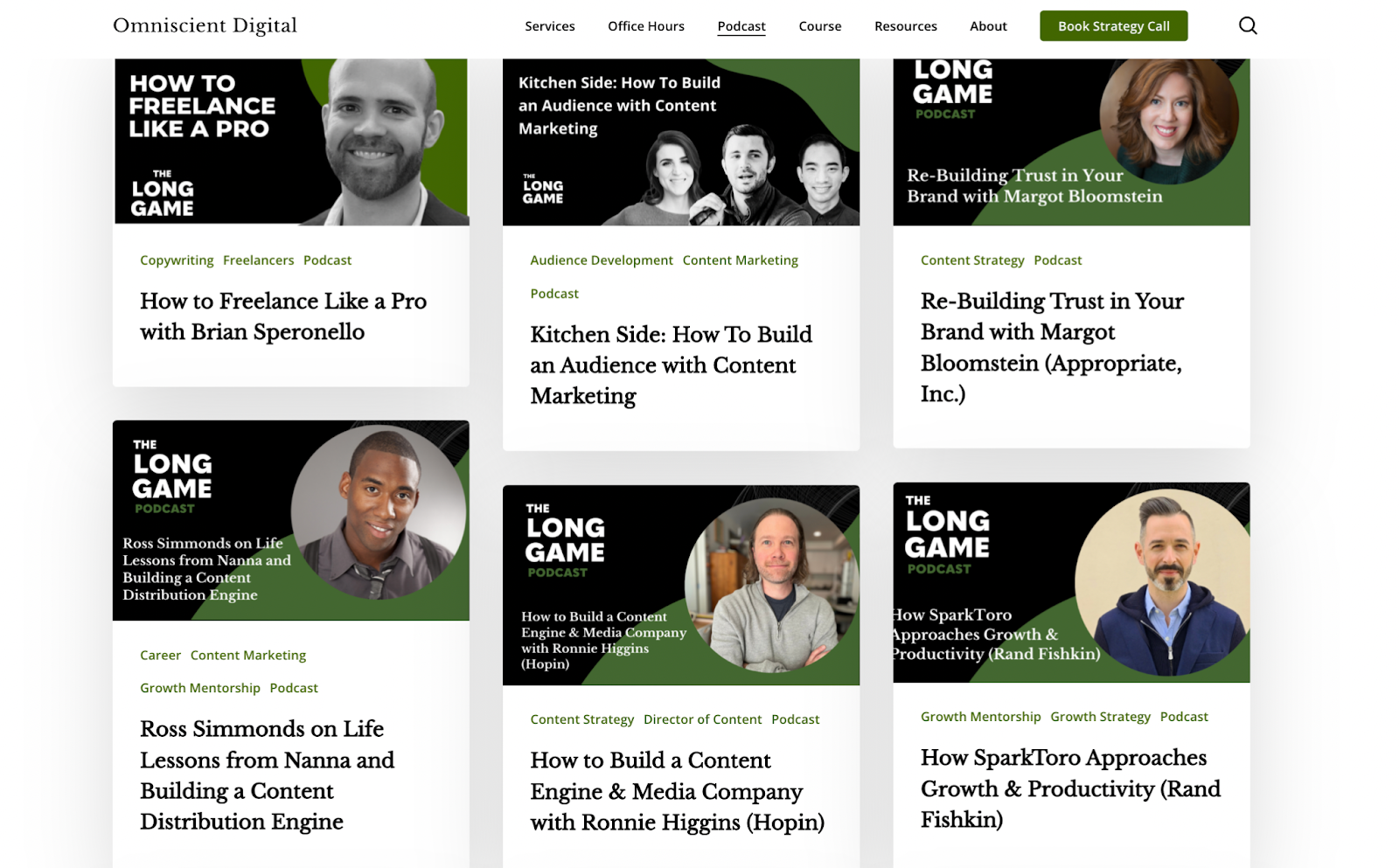
Here’s the problem, though: it’s hard to grow a podcast. It’s particularly hard to do so when you don’t have a large marketing budget or a built-in audience like large brands have.
We’ve tried a lot of things:
- Getting bigger guests on the show and nudging them to promote to their audience.
- Running giveaways to try to incentivize reviews.
- Repurposing to YouTube, our blog, and social.
All of it is marginally effective, and we were growing month-over-month.
But a few months ago, I had a thought: we’re a content agency. Why don’t we use some of our own strategies and tactics we use with our clients to grow our own podcast?
Of the many strategies we could have chosen, I decided the “Surround Sound SEO Strategy” would be the perfect approach.
Solution: Surround Sound SEO Strategy outreach and partnerships
First, a quick introduction to the Surround Sound SEO Strategy.
When you want to read a new book or watch a new TV show, what do you do?
If you’re like me, you ask your friends (or Twitter) what they’ve been watching or reading.
Imagine if, upon asking for recommendations, one friend says, “I just read Three Body Problem, and it was incredible.”
Just one recommendation puts the book on your radar, but it doesn’t necessarily compel you to go out and buy it.
Now imagine everyone in that group says, “Three Body Problem!”
You’re almost certainly going to end up reading that book.
Repeated positive exposure leads to increased propensity to purchase.
This works shockingly well in software, ecommerce, and other areas online as well. We just use Google (or Twitter) instead of a group of friends. In the online case, it looks like someone searching Google for the “best content marketing podcasts”
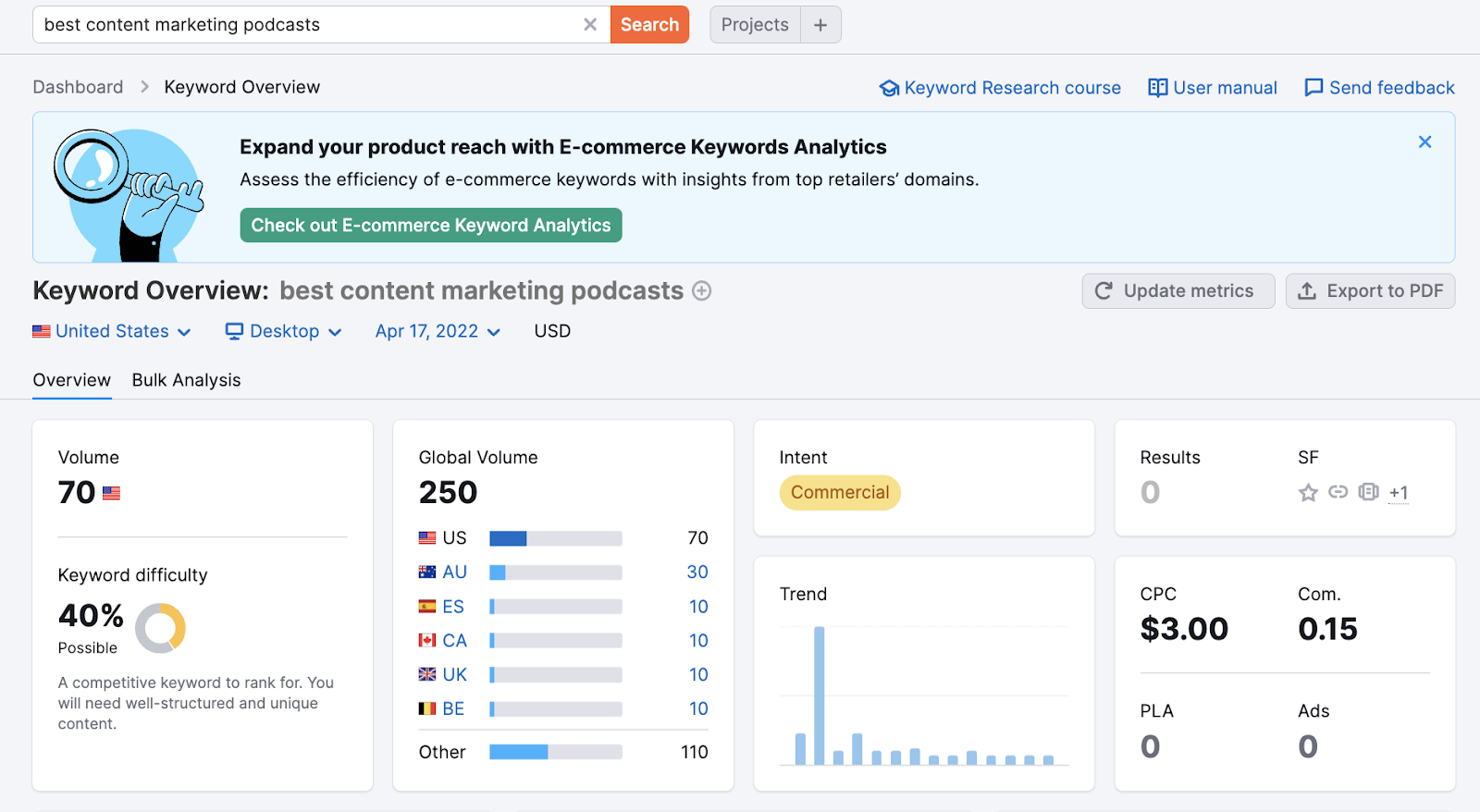
Or simply: “content marketing podcast”

While the volume on these keywords isn’t tremendous, it is incredibly high intent. Searching these phrases is essentially somebody directly asking for a podcast recommendation, and if you don’t come up at all in these SERPs, you’re functionally not in the conversation or consideration.
Our goal became to monopolize the search results pages for these keywords. On every single article about the “best content marketing podcasts,” we wanted to get mentioned, preferably in the first position on the list.
That way, when someone searches for one of these phrases, it would be the online equivalent of everyone at the cocktail party recommending The Long Game podcast when asked, “what podcast should I check out?”
Step 1: Audit Existing SERPs
With the help of Semrush’s Surround Sound tool, we logged a few keywords (“best content marketing podcasts” and “content marketing podcast”) and had a look at the existing search results pages.
I don’t have a screenshot of the data from the time before we started the campaign, but effectively, we weren’t listed on a single page that ranked for these keywords. We had 0% coverage when we started out.
We were completely absent from the conversation.
The good news was that there was nowhere to go but up in terms of visibility.
Step 2. Find Opportunities for High-Impact Mentions
While traditional SEO focuses on ranking your own site for your keywords, Surround Sound SEO helps you take advantage of pages that already rank. You’ll be looking for articles like, “12 Podcasts for Marketers,” essentially list articles where the publisher may be willing to mention you. That way, your coverage in the SERPS goes far beyond what you could capture with your domain alone.
Here, I’ve set up a demo campaign in Surround Sound to show where competitors of “My podcast” are mentioned but “My podcast” is not. These pages are prime candidates for gaining new mentions.

By targeting top pages like this, you can see now that we’ve already increased our visibility substantially:

While we don’t have “competitors,” per se, I found it helpful to add in Siege Media’s “Content and Conversation” podcast. Their podcast is somewhat similar to ours. So this way, I could see where they were appearing that we weren’t, and start doing outreach to get on those lists.
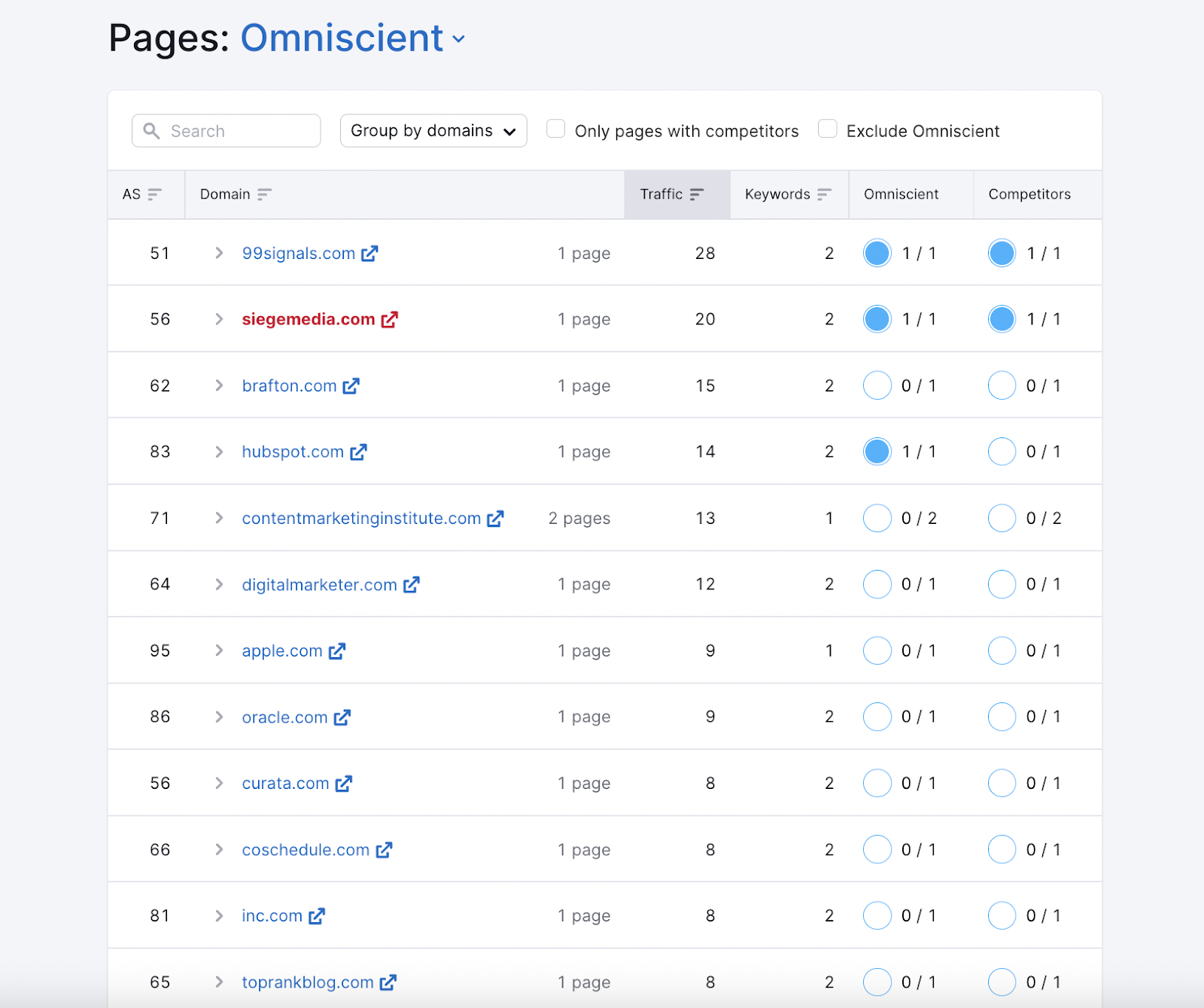
Step 3: Find contact information and prioritize outreach
After auditing the SERPs for our keywords, “content marketing podcast” and “best content marketing podcast,” we identified the opportunities for placement and got to work.
Generally, there are two strategies to increase your SERP coverage:
- Get added to existing content
- Create your new content
To get added on existing content, you first need to find the contacts at each company, which is relatively easy to do with LinkedIn and a few other free or cheap tools.
Let’s walk through the 99signals article for example.

Ideally, you want to find the person in charge of the blog. Sometimes the byline is a freelance writer or guest writer who doesn’t actually have the authority to change their post. In this case, I can clearly see the byline name is the same as the name of the website owner (listed on the right hand side bar), so now I just have to find Sandeep’s contact info.
The best way to find email addresses is to use LinkedIn and an email prospecting tool like Hunter or ContactOut.
Often, you can also just guess email formulas, such as firstname.lastname@company.com.
In this case, I did not already know Sandeep, but I reached out and offered him a spot on our podcast, which he accepted. And he was happy to add us to his article!
Like I mentioned, sometimes the author of the piece isn’t in charge of the blog. This is the case with a Coschedule post that ranks:

When this is the case, I search LinkedIn for those that work at the company and have “marketing” in their title. I’m fishing for something like “head of marketing” or “content marketing manager.”
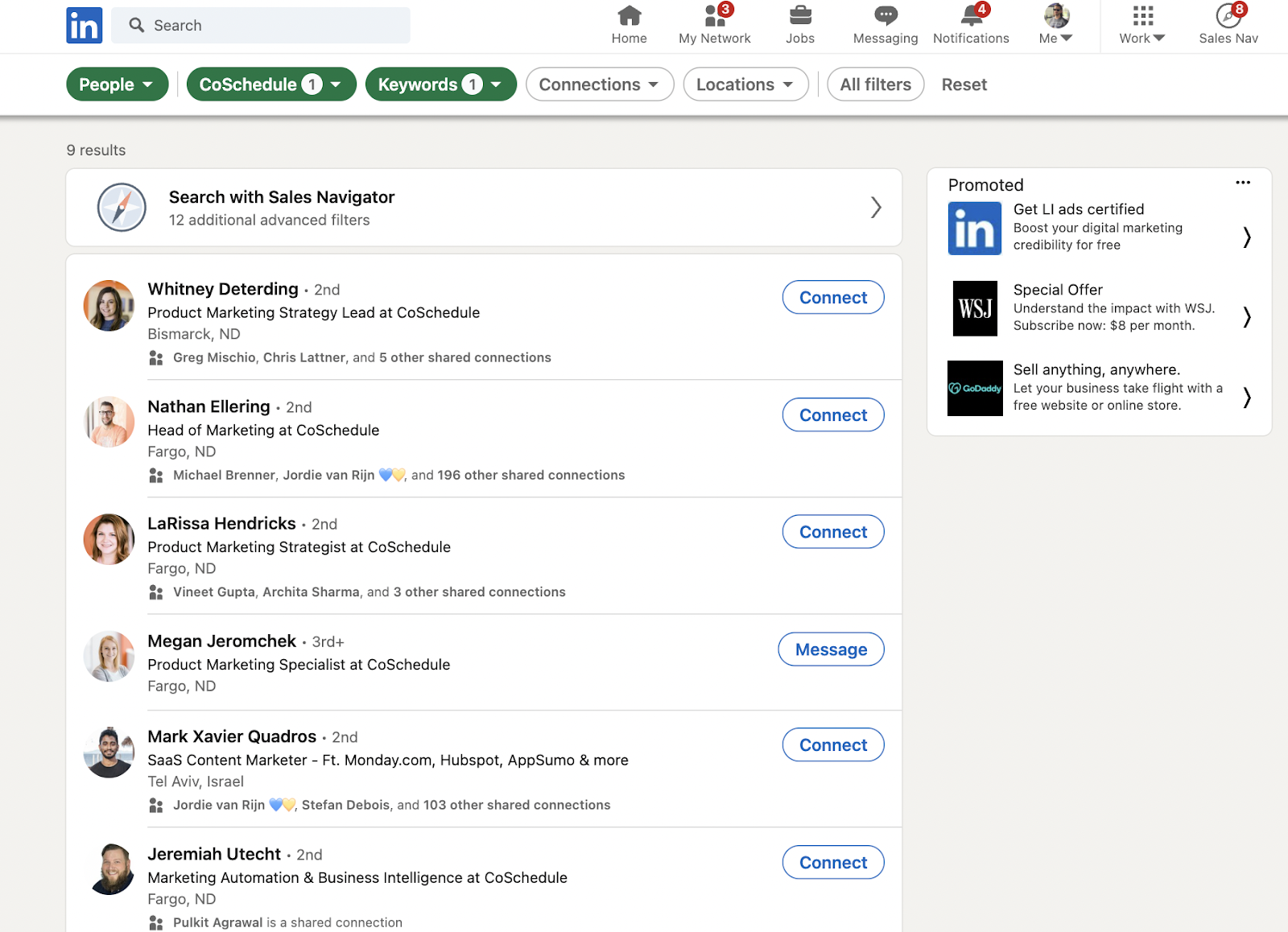
All of this then gets compiled onto a list with contact info, title, and LinkedIn profile.
A large part of the battle is just finding the right person to reach out to. Once you do, though, you can nurture that connection into a relationship that can go beyond getting one mention or link for your brand.
Step 3.5: Create Your Own Content
As for creating new content, you can do one of two things:
- Publish on your own blog
- Partner with others and publish on their blogs
If you have a high authority website, publishing a listicle on your own blog is obvious and low hanging fruit. If you have friends who want free content, getting published on their blogs is a great way to appear on the SERPs for your keywords.
We did both.
The first thing we did was create our own content. I wrote a blog post on Omniscient’s blog titled “The 8 Best Content Marketing Podcasts in 2021” and it now ranks on page one for our keywords:
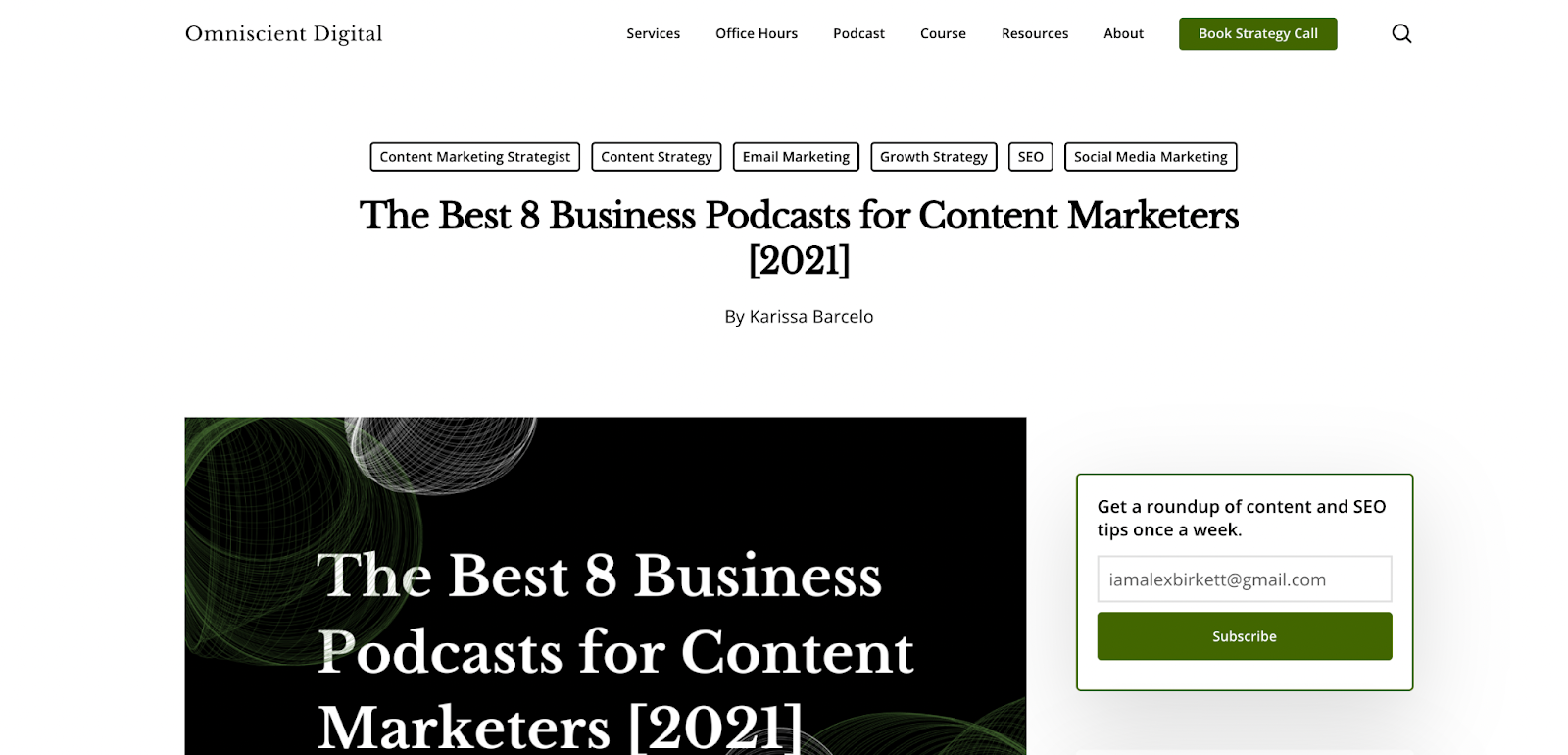
I also have my personal blog, so I wrote a similar list there, “The 14 Best Content Marketing Podcasts in 2022.” Oh yeah, I skyscrapered my own blog post:
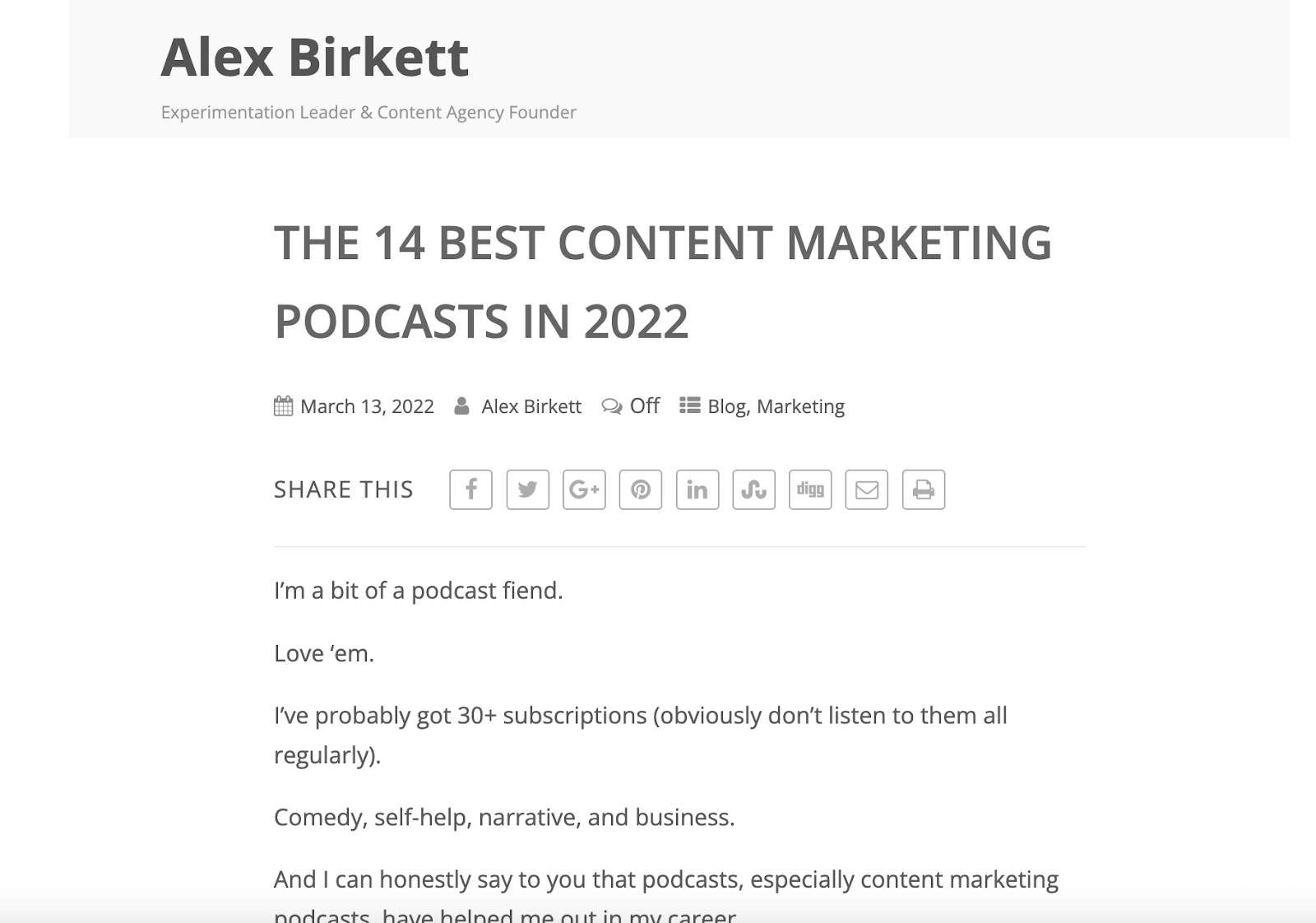
If you can write well and have the website authority to pull this off, writing your own listicle is a great way to break onto the SERPs. You also get all the click and conversion data for yourself. As I’ll mention later, it’s also a great leverage technique to negotiate with other existing pages.

But as it stands, writing two posts of our own took us from 0% coverage to 10% coverage (looking at the top 20 results).
Step 4: Conduct Email Outreach and Establish Partnerships
Next up, it’s time to play account executive. We’re basically doing sales at this point, but the “sale” here is getting someone to add you to their listicle.
If you have a SERP dominated by review sites like Capterra and G2, this approach will be different as you’ll have to play by their rules (either paying to appear or getting enough reviews to be listed prominently).
For bloggers, affiliates, and publications, however, we can negotiate a position if we have enough of an incentive for them to do so.
Essentially, to create behavior change (i.e. adding us to their listicle), we can do two things:
- Increase motivation
- Decrease friction
To increase motivation, we add a few incentives for them:
- If they have a podcast, we can add it to our list in exchange for a placement on theirs
- If they’re working in content, we can include them on our podcast or virtual event series
More generally, we can offer an open-ended “content partnership” that could include guest post swaps, social promotion, or other co marketing efforts.
To decrease friction, we offer to write a blurb for them so they don’t have to spend an hour writing something about our podcast.
I’ll show a few example outreach emails I sent.
This one was sent to a company that offers podcast services, so we offered to send leads and partner with them on their service (since we get requests like this every so often):

This one was sent to a high traffic blog with a founder who has been on many podcasts, so we offered a podcast spot:

And sometimes, I like to just send a blunt, straight to the point email (and this actually works really well in a world filled with marketing fluff):

Step 5: Turn up the Volume on Your Surround Sound SEO Strategy
As you start to send emails, you’ll get a feel for what works and what doesn’t.
You also start to get a snowball effect as you start your strategy.
The first mention is the hardest. The second is a little bit easier. Eventually, you’ll be mentioned in so many places that all new listicles written on the subject will mention you naturally, because writers will research the existing content that ranks for the keyword.
So where do we stand today? We’re at 45.6% for our main keyword, “best content marketing podcasts” and 28.4% for “content marketing podcast.” There are some similarities in the two SERPs, of course.
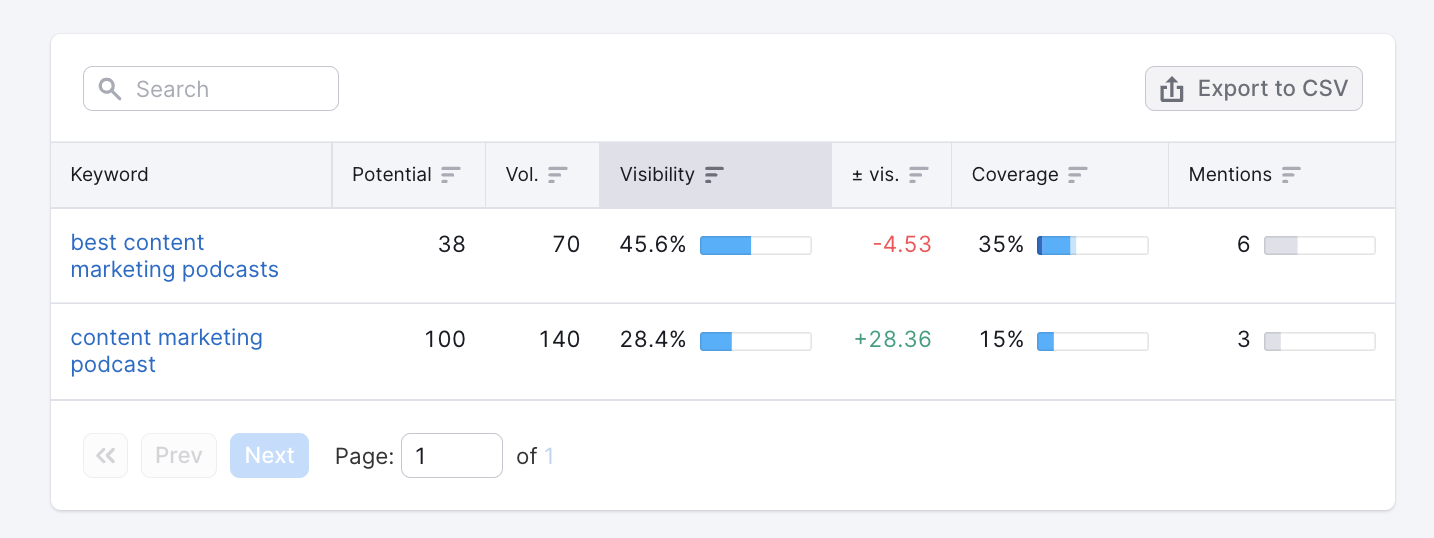
We’ve also got two placements in the works, so we’ll soon pass 50% and then, eventually, hope to hit 100% brand visibility.
What's Next for Our Share of Voice Quest?
Scaling to other business-critical keywords.
One thing that helps with scaling the surround sound strategy is creating assets that give you leverage. For us, that means writing blog post roundups and listicles that feature software products, podcasts, books, and courses in our niche.
If we have these assets, we can offer placements on these lists in exchange for a mutual placement on their list.
For example, we have a list of content marketing courses we used as leverage (offering Siege Media a place on the list):

This use of content marketing - that of writing for leverage and partnerships, not just for direct conversions - is underrated. It opens up the pathway to opportunities and partnerships that are otherwise hard to access.
The other thing that helps you scale is tracking, auditing, and analytics. We do all of this in Semrush’s Surround Sound tool, which allows us to track competitors and hundreds of keywords.
For example, one of the next sets of keywords we’ll go for (which will have direct revenue attribution, unlike our podcast) will be around “content marketing agency” keywords:

We’re obviously very low visibility here:

But with this tool, it’s now easy for us to scope out partnership opportunities, and with our surround sound playbook we will get massive coverage here as well.

The Results: 45.6% coverage and continuing to grow
Summing up, in just three months of dedicated effort (at 3 to 5 hrs/week), we managed to:
- Increase our search visibility for our core keyword from 0% to 45.6%
- Build ongoing content partnerships with several site owners to write new guest posts for their blogs
- Get three great new podcast guests to interview
We also increased our podcast downloads month-over-month, but out of intellectual integrity, I can’t say how much of that was due specifically to the surround sound strategy (many confounding factors are at play). But we know now we’re in the conversation when people are searching for “best content marketing podcasts.”
Conclusion: How Omniscient Digital Increased Share of Voice from Zero to 45.6% to Drive Podcast Downloads (and how you can, too)
The surround sound strategy is a viable strategy for anyone hoping to increase their share of voice for search keywords. In executing this strategy for our podcast, we did the following:
- Found high intent keywords related to “content marketing podcasts” using Semrush
- Identified placement opportunities for these keywords using the Surround Sound tool
- Created our own listicles for these keywords to begin ranking and appearing in SERPs
- Conducted email outreach to get listed on other publications
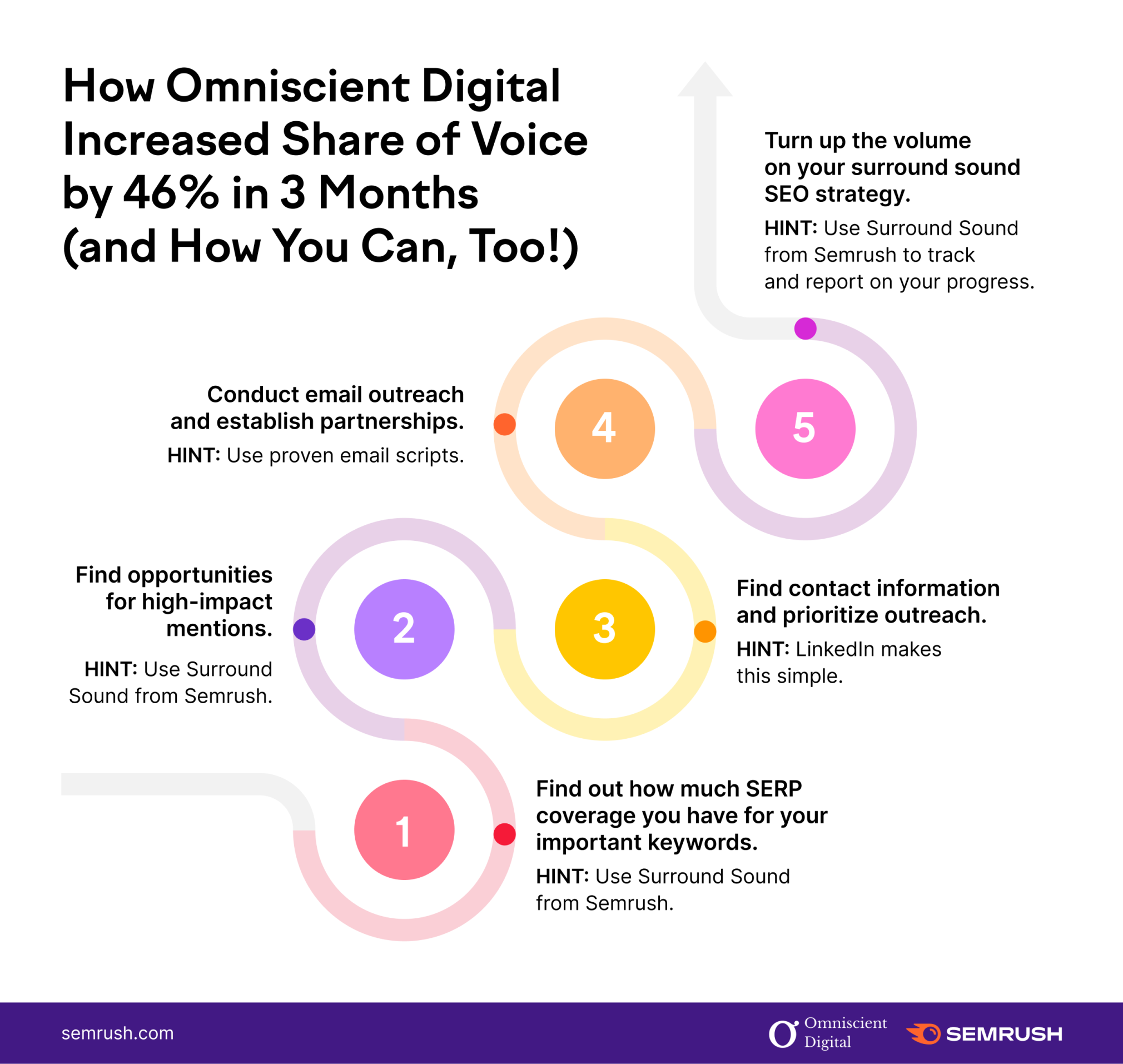
While your keywords and methods may be different, at heart this strategy is applicable to most companies and industries. Will you try it for your business?
